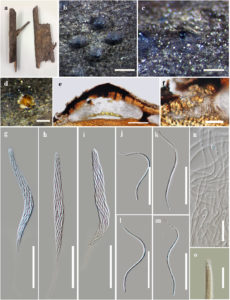Leptosporella arengae Konta & K.D. Hyde, in Konta, Hongsanan, Liu, Eungwanichayapant, Jeewon, Hyde, Maharachchikumbura & Boonmee, Mycosphere 8(10): 1959 (2017)
Index Fungorum number: IF 553957
Etymology – The specific epithet refers to the host genus Arenga
Holotype – MFLU 15–0305
Saprobic on rachis of Arenga pinnata (Wurmb) Merr. Sexual morph Ascomata 582–928 μm diameter × 293–354 μm high (x̅ = 777 × 333 μm, n = 10), solitary, superficial, comprising black, carbonaceous, dome-shaped, raised blister-like areas, subglobose, flattened at the base, ostiole central. Peridium 78–150 μm diameter (x̅ = 104 μm, n = 10), outer cells merging with the host epidermal cells, composed of dark brown to black cells of textura angularis. Hamathecium comprising numerous, 1.5–3 μm diameter (x̅ = 2 μm, n = 10), hyaline, hypha-like, septate paraphyses, longer than asci. Asci 137–190 × 10–14 μm (x̅ = 160 × 12 μm, n = 20), 8-spored, unitunicate, cylindrical, long-pedicellate, with a J-, wedge-shaped, subapical ring. Ascospores 108–132 × 2–3.5 μm (x̅ = 122 × 3 μm, n = 20), fasciculate, spiral, filiform, straight or curved, C-shaped or sigmoid, hyaline or pale-yellowish in mass, aseptate, ends rounded, with polar mucilaginous appendages, smooth-walled. Asexual morph Undetermined.
Culture characters – Ascospores germinating on MEA within 3 days. Colonies on MEA reaching 6–7.5 cm diameter after two months at 25°C, white at the edge, brown in the center with strong radiations outwards; after 30 days of incubation, colonies smooth-walled, flat, margin lobate, white at the center and become brown at the margin, hyphae, septate, branched and smooth-walled.
Material examined – THAILAND, Phang-Nga Province, on dead rachis of Arenga pinnata (Wurmb) Merr. (Arecaceae), 5 December 2014, Sirinapa Konta, PHR07a (MFLU 15–0305, holotype); HKAS100704, isotype; ex-type living culture, MFLUCC 15–0330. GenBank numbers: SSU: MG366594; TEF: MG272259; RPB2: MG272260.
Notes – Leptosporella arengae is introduced as a new species based on its unique morphology and phylogeny. It differs from other species in Leptosporella in having cylindrical, long pedicellate, thin-walled asci and spiral, filiform, straight or curved, C-shaped or sigmoid ascospores with polar mucilaginous appendage at the apex (Table 1). However, it shares similarity with other species, it has solitary, superficial, carbonaceous, dome-shaped ascomata, asci with J-, subapical ring, and hyaline ascospores. Phylogenetic analysis indicates that Leptosporella arengae clusters with L. cocois (93% BS), but differs in having smaller ascomata, asci, ascospores, aseptate with a mucilaginous appendage ascospores, while L. cocois has larger ascomata, paraphyses, asci, ascospores without mucilaginous appendage, and 2–4-septate when ascospore geminated. Sequence data are available only for L. gregaria and L. bambusae, and with two unidentified strains.

Fig 1. Leptosporella arengae (MFLU 15–0305, holotype). a Appearance of ascomata on host substrate. b, c Close up of ascomata. d Yellowish ascospore mass. e Section of ascoma. f Peridium. g–i Asci. j–m Ascospores. n Paraphyses. o J- reaction of apical ring. Scale bars: b = 1,000 μm, c–d = 500 μm, e = 200 μm, f–m = 50 μm, n–o = 20 μm.
